七年级下册第三单元语法重点
- 格式:pptx
- 大小:110.10 KB
- 文档页数:19
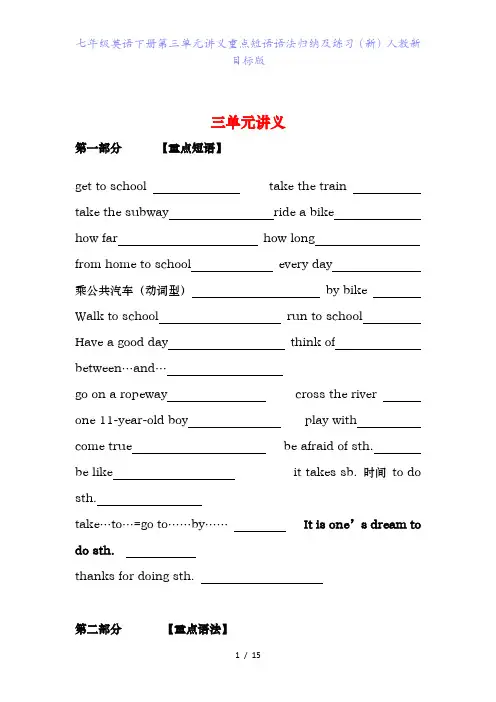
三单元讲义第一部分【重点短语】get to school take the traintake the subway ride a bikehow far how longfrom home to school every day乘公共汽车(动词型)by bikeWalk to school run to schoolHave a good day think of between…and…go on a ropeway cross the riverone 11-year-old boy play withcome true be afraid of sth.be like it takes sb. 时间to do sth.take…to…=go to……by…… It is one’s dream to do sth.thanks for doing sth.第二部分【重点语法】一、交通方式表达法1.动词型: take +限定词(a/an/the)+交通工具(单数)(take 译为乘坐,动词型通常放在句中)如:take a /the bus , take a/the subway, take a/the train 例:Tom takes a bus to school.翻译(Linda坐地铁去图书馆):Lindalibrary.◆有的交通工具不需要用take,如walk to/drive to /ride to/flyto/◆Walk to +地点=go to ...on foot走路去…如:I walk to school every day.=I go to school on foot.注意:如果后面接地点副词here , there , home 等介词to应省去2.介词型:1)by+交通工具(单数)(中间无任何修饰词,介词型通常位于句末)如:by bus/by subway/by train例:Tom goes to Beijing by train.2)in/on +限定词(a/an/the)+交通工具(单数)(位于句末,特别强调在自行车上用on)如:in a /the car, in a /the boat, in a/the taxiOn a /the bus, on a /the train, on a /the subway例:My father goes to work on a bus/in a car.注意:1.对交通工具提问用:how(怎样)如:My father goes to work on a bus(对划线部分提问)How does your father go to work?【试一试】1. I think you can _____to the new park. It’s a little far.A. by busB. take a busC. onfoot D. walk2. –-How does your brother usually go to school?–- ______car.A. ByB. InC. OnD. With3. I often go to school _____ my father’s car and go back home ______ foot.A. in; onB. by; byC. by; inD.on; by4. Jim often goes to school ______ bike. But today he goes to school ______ the school bus.A. on; byB. by; byC. by; onD. on; on二、交通方式之间的互换。
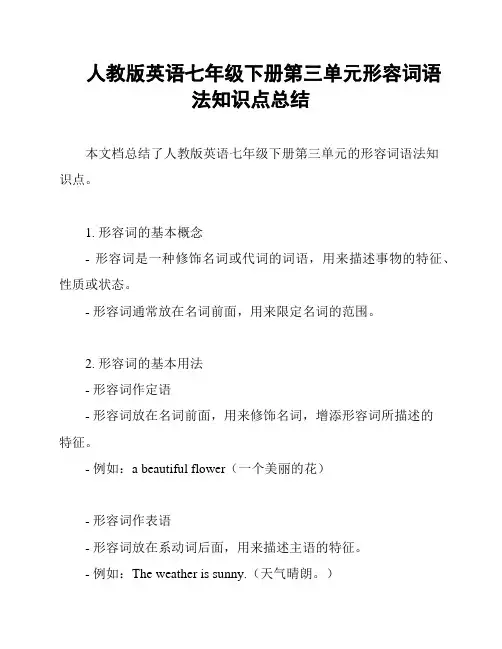
人教版英语七年级下册第三单元形容词语法知识点总结本文档总结了人教版英语七年级下册第三单元的形容词语法知识点。
1. 形容词的基本概念- 形容词是一种修饰名词或代词的词语,用来描述事物的特征、性质或状态。
- 形容词通常放在名词前面,用来限定名词的范围。
2. 形容词的基本用法- 形容词作定语- 形容词放在名词前面,用来修饰名词,增添形容词所描述的特征。
- 例如:a beautiful flower(一个美丽的花)- 形容词作表语- 形容词放在系动词后面,用来描述主语的特征。
- 例如:The weather is sunny.(天气晴朗。
)- 形容词作宾语补足语- 形容词放在及物动词的后面,用来补充说明宾语的特征。
- 例如:They found the book interesting.(他们发现这本书很有趣。
)3. 形容词的比较级和最高级- 形容词的比较级用于比较两个或多个事物的特征。
- 比较级的构成:原形 + er + than- 例如:taller than(比...更高)- 形容词的最高级用于比较三个或三个以上事物的特征。
- 最高级的构成:the + 原形 + est- 例如:the tallest(最高的)4. 形容词的位置- 形容词一般放在名词前面,但有时也可以放在名词后面。
- 当形容词修饰不可数名词或定物名词时,通常放在名词前面。
- 例如:a beautiful girl(一个美丽的女孩)- 当形容词修饰人或个体名词时,通常放在名词后面。
- 例如:a boy happy(一个快乐的男孩)以上是人教版英语七年级下册第三单元的形容词语法知识点总结。
希望对你有所帮助!。
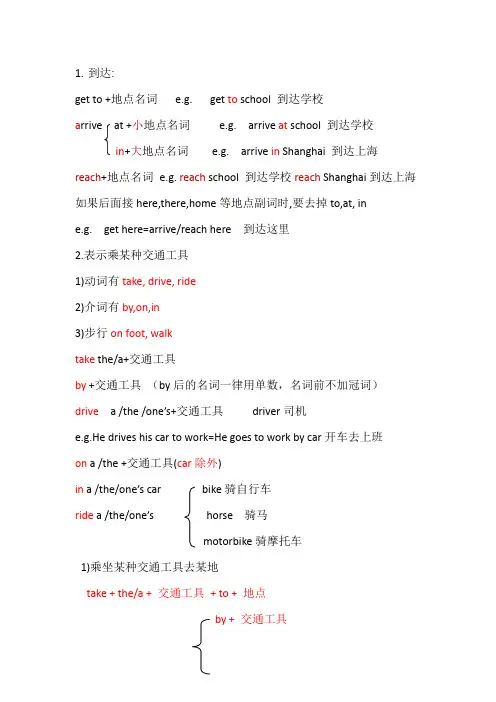
1.到达:get to +地点名词 e.g. get to school 到达学校a rrive at +小地点名词 e.g. arrive at school 到达学校in+大地点名词 e.g. arrive in Shanghai 到达上海reach+地点名词e.g. reach school 到达学校reach Shanghai到达上海如果后面接here,there,home等地点副词时,要去掉to,at, ine.g. get here=arrive/reach here 到达这里2.表示乘某种交通工具1)动词有take, drive, ride2)介词有by,on,in3)步行on foot, walktake the/a+交通工具by +交通工具(by后的名词一律用单数,名词前不加冠词)drive a /the /one’s+交通工具driver司机e.g.He drives his car to work=He goes to work by car开车去上班on a /the +交通工具(car除外)in a /the/one’s car bike骑自行车ride a /the/one’s horse 骑马motorbike骑摩托车1)乘坐某种交通工具去某地take + the/a + 交通工具+ to + 地点by + 交通工具= get/go to + 某地+ on a /the +交通工具in a /the/one’s care.g.My uncle always goes to work in his car.我叔叔总是开车上班。
=My uncle always goes to work by car.=My uncle always takes his car to work.2)骑……去某地ride a /the/one’s + 交通工具+ to + 地点3)走路去某地walk to + 某地4)= get/go to + 某地+ on footon foot 表示“步行;走路”,而不是by foot 或on feet当home, here, there 作地点时, 不加to。
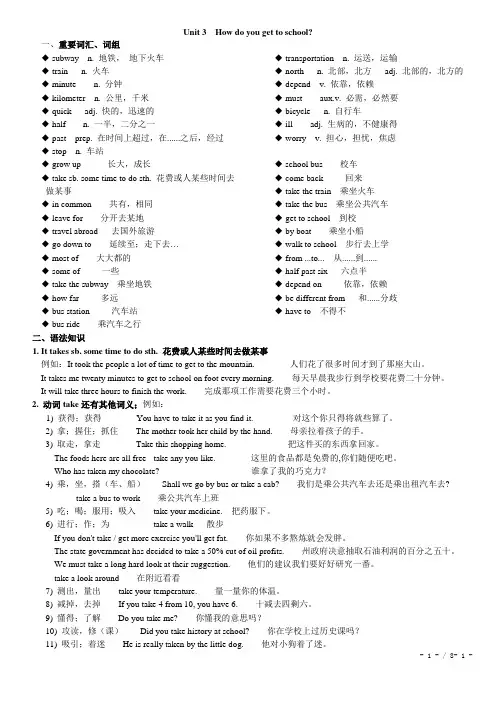
Unit 3 How do you get to school?一、重要词汇、词组◆ subway n. 地铁,地下火车◆ train n. 火车◆ minute n. 分钟◆ kilometer n. 公里,千米◆ quick adj. 快的,迅速的◆ half n. 一半,二分之一◆ past prep. 在时间上超过,在......之后,经过◆ stop n. 车站◆ transportation n. 运送,运输◆ north n. 北部,北方adj. 北部的,北方的◆ depend v. 依靠,依赖◆ must aux.v. 必需,必然要◆ bicycle n. 自行车◆ ill adj. 生病的,不健康得◆ worry v. 担心,担忧,焦虑◆ grow up长大,成长◆ take sb. some time to do sth. 花费或人某些时间去做某事◆ in common 共有,相同◆ leave for 分开去某地◆ travel abroad 去国外旅游◆ go down to延续至;走下去…◆ most of大大都的◆ some of一些◆ take the subway乘坐地铁◆ how far多远◆ bus station汽车站◆ bus ride乘汽车之行◆ school bus校车◆ come back回来◆ take the train乘坐火车◆ take the bus乘坐公共汽车◆ get to school到校◆ by boat乘坐小船◆ walk to school步行去上学◆ from ...to...从......到......◆ half past six六点半◆ depend on依靠,依赖◆ be different from和......分歧◆ have to不得不二、语法知识1. It takes sb. some time to do sth. 花费或人某些时间去做某事例如:It took the people a lot of time to get to the mountain.人们花了很多时间才到了那座大山。

人教版七年级英语下册Unit 3 How do you get to school?一、重点讲解1.take a/the train搭火车用动词短语表示交通方式,有以下两种情况:①用“take a/ the +交通工具名词”表示交通方式。
如: take a bus(乘公共汽车), take a ship(乘轮船), take a plane (乘飞机), 但“骑自行车”要用ride a bike来表示。
如: They often take a train to Beijing. 他们经常乘坐火车去北京。
②用某种动词来表示交通方式。
如:walk to(步行去),drive to(开车去),ride to(骑马/车去), fly to (乘飞机去)等。
2.how far 离…….多远,用来询问距离。
回答该问句常用It’s …meters/ kilometers/miles.如:–How far does your uncle live from here? 你叔叔住的地方离这儿有多远?–It’s 5 kilometers. 五千米。
3.cross= go/ walk across横穿+ road/street/bridge马路/街道/桥4. there be句型表示“某地存在有某人或某物”,要用就近原则。
拓展:not only…but also(不但…而且), either…or(不是…就是), neither…nor(既不…也不)也用就近原则。
如:There is a pen and two books on the desk. There are two books and a pen on the desk.5.W hy not do…?为什么不做...?类似句型:Why don’t you do…? 为什么不做...?二.同步句型&讲解1.How do you get to school? I ride my bike. 你怎样去学校?我骑自行车去。

how引导的一般现在时的特殊疑问句how引导的一般现在时的特殊疑问句可用how来提问交通方式;用how long提问时间长短,即时间段;用how far提问距离。
1.How用来提问交通方式:How do/does sb. go to get to…?其答语有:(1)take a /the+表示交通工具的名词;(2)by+表示交通工具的名词;(3)on/in+限定词+表示交通工具的名词。
例句:—How do you go to work every day? 你每天怎样去上班?—I take a bus to work. = I go to work by bus/on the bus.我乘公汽去上班。
how引导的特殊疑问句也可用于询问方式、程度、天气、健康、年龄、身高、数量等。
用法例句询问年龄/数量/次数/身高—How old is she? 她几岁?—She’s 23.她23岁。
How many books do you have?你有多少本书?How many times do you have pills every day?你每天吃几次药?询问健康状况How is your mother?你母亲身体怎么样?询问天气—How’s the weather today? 今天的天气怎么样?—It’s sunny.是晴天。
询问方式、手段—How can I do well in English? 我怎样才能学好英语?—By reading every morning.通过每天早上多读书。
询问程度—How do you like Wuhan? 你认为武汉怎么样?—I like it very much.我非常喜欢它。
2.how long用来提问时间长短,意为“多长时间”,还可以用来提问物体的长度,意为“多长”。
例句:How long does it take you to walk to school? 走到学校花费你多长时间?How long is the river? 这条河多长?3.how far用来提问距离,意为“多远”。
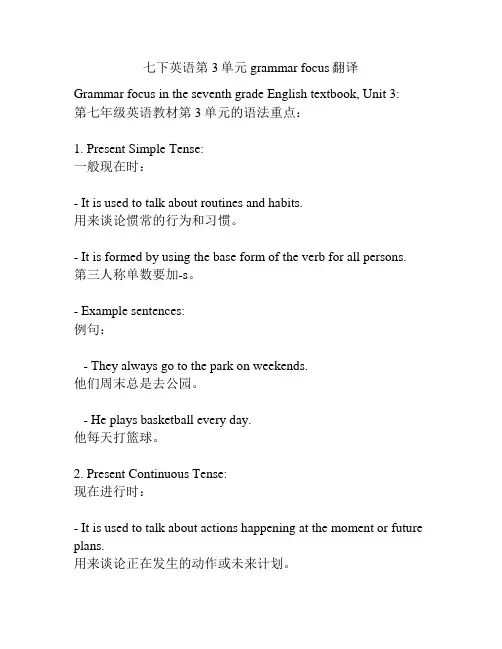
七下英语第3单元grammar focus翻译Grammar focus in the seventh grade English textbook, Unit 3:第七年级英语教材第3单元的语法重点:1. Present Simple Tense:一般现在时:- It is used to talk about routines and habits.用来谈论惯常的行为和习惯。
- It is formed by using the base form of the verb for all persons. 第三人称单数要加-s。
- Example sentences:例句:- They always go to the park on weekends.他们周末总是去公园。
- He plays basketball every day.他每天打篮球。
2. Present Continuous Tense:现在进行时:- It is used to talk about actions happening at the moment or future plans.用来谈论正在发生的动作或未来计划。
- It is formed by using the present participle form of the verb (verb + -ing).使用动词现在分词形式(动词+ing)。
- Example sentences:例句:- I am currently studying for my exams.我正在备考。
- She is going to the store later.她待会儿要去商店。
3. Adverbs of frequency:频度副词:- They are used to express how often something happens.用来表示某事发生的频率。
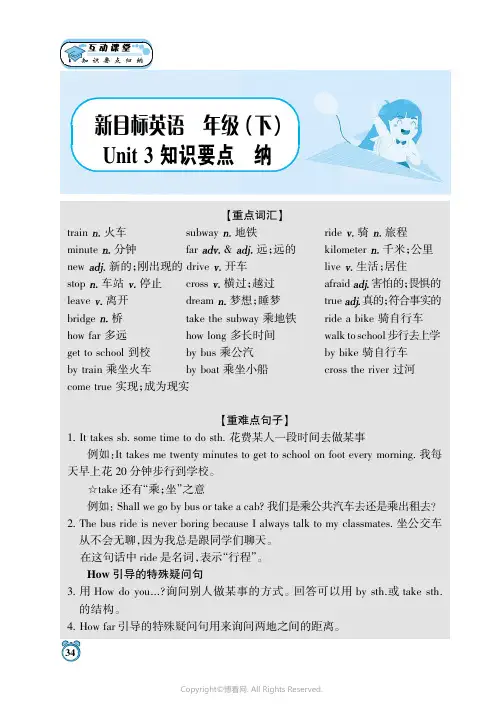
知【重点词汇】train火车subway 地铁ride 骑旅程minute 分钟far &远;远的kilometer千米;公里new 新的;刚出现的drive 开车live 生活;居住stop 车站停止cross 横过;越过afraid 害怕的;畏惧的leave 离开dream 梦想;睡梦true 真的;符合事实的bridge 桥take the subway 乘地铁ride a bike 骑自行车how far 多远how long 多长时间walk to school 步行去上学get to school 到校by bus 乘公汽by bike 骑自行车by train 乘坐火车by boat 乘坐小船cross the river 过河come true 实现;成为现实【重难点句子】1.It takes sb.some time to do sth.花费某人一段时间去做某事例如:It takes me twenty minutes to get to school on foot every morning.我每天早上花20分钟步行到学校。
☆take 还有“乘;坐”之意例如:Shall we go by bus or take a cab?我们是乘公共汽车去还是乘出租去?2.The bus ride is never boring because I always talk to my classmates.坐公交车从不会无聊,因为我总是跟同学们聊天。
在这句话中ride 是名词,表示“行程”。
How 引导的特殊疑问句3.用How do you...?询问别人做某事的方式。
回答可以用by sth.或take sth.的结构。
4.How far 引导的特殊疑问句用来询问两地之间的距离。
34Copyright ©博看网. All Rights Reserved.。

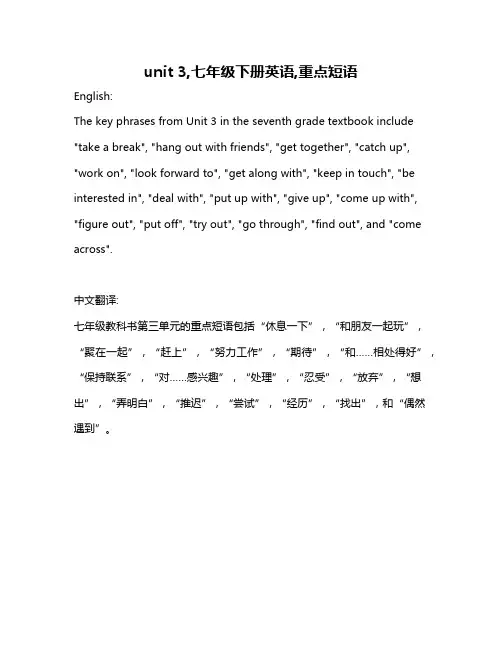
unit 3,七年级下册英语,重点短语
English:
The key phrases from Unit 3 in the seventh grade textbook include "take a break", "hang out with friends", "get together", "catch up", "work on", "look forward to", "get along with", "keep in touch", "be interested in", "deal with", "put up with", "give up", "come up with", "figure out", "put off", "try out", "go through", "find out", and "come across".
中文翻译:
七年级教科书第三单元的重点短语包括“休息一下”,“和朋友一起玩”,“聚在一起”,“赶上”,“努力工作”,“期待”,“和……相处得好”,“保持联系”,“对……感兴趣”,“处理”,“忍受”,“放弃”,“想出”,“弄明白”,“推迟”,“尝试”,“经历”,“找出”,和“偶然遇到”。
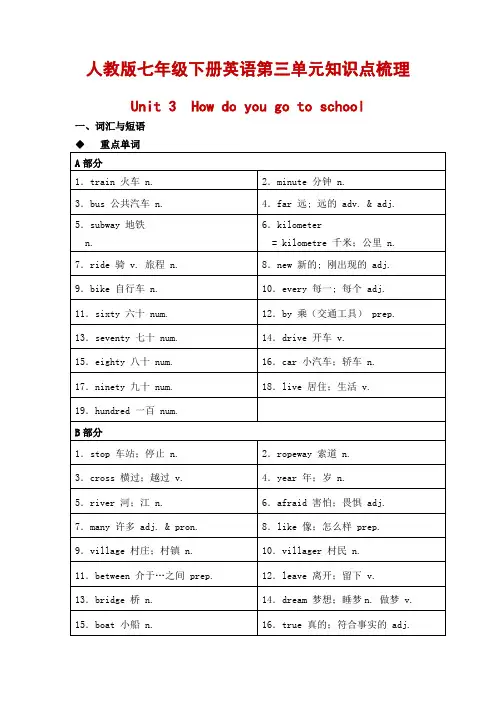
人教版七年级下册英语第三单元知识点梳理Unit 3 How do you go to school一、词汇与短语◆重点单词◆重点句子◆重点单词变形二、语法知识点A部分知识点1.与how构成的词组引导的特殊疑问句❶ how表示爱好、程度、看法等,意为“……怎么样?”。
eg:—How do you like the music?你觉得这首乐曲如何?—I like it very much.我非常喜欢它。
How is your Chinese?你的汉语如何?How do you like China?你认为中国怎么样?❷用于询问身体健康状况,意为“……怎么样?”。
eg:How do you do?你好!How are you?你(身体)好吗?❸ how提问交通方式。
其答语分三种情况:◆take a/the+表示交通工具的名词◆by +表示交通工具的单数名词◆on/in+限定词+表示交通工具的名词eg:How do you go to workevery day? 你每天怎样去上班?I take the subway to work. 我乘地铁去上班。
=I go to work by subway.=I go to work in the subway.❹表示感叹。
eg:How cold it is today!今天好冷啊!How hard they are working!他们在多么辛勤地劳动啊!How fast he runs!他跑得多快啊!❺表示某种方式、手段或方法。
eg:How do you spell it?你怎样拼写它?How did he go to schoolyesterday?他昨天是怎样去上学的?How do you know about it?你怎么知道这件事的?❻ how about用于询问或征询意见等,相当于what about,后接名词、代词或动词的-ing形式,意为“……怎么样?”。
初一下册三单元语法
初一下册第三单元的语法:
1. 一般现在时:学习一般现在时的用法,包括肯定句、否定句和疑问句的构成,以及用于表示经常性或习惯性的动作、状态或事实。
2. 人称代词和物主代词:进一步学习人称代词(如I, you, he, she, it 等)和物主代词(如my, your, his, her, its 等)的用法,包括主格和宾格形式。
3. 名词复数:学习名词复数的构成规则,例如加-s 或-es,以及一些不规则复数形式。
4. 方位介词:学习一些常用的方位介词,如in, on, under, behind, near 等,用于描述物体的位置关系。
5. 特殊疑问句:学习如何用特殊疑问词(如what, where, when, how 等)来构成特殊疑问句,并学会如何回答这些问题。
七年级下册讲义Unit 3 How do you get to school?一、重点单词1.火车train2.bus 公共汽车3.subway 地铁4.ride 骑;旅程5.bike 自行车6.sixty 六十7.seventy 七十8.eighty 八十9.ninety 九十10.hundred 一百11.minute 分钟12.far 远;远的13.kilometer 千米;公里14.new 新的15.every 每一个16.by 表示方式;乘17.drive 开车18.car 小汽车19.live 居住;生活20.stop 车站;停止21.river 河;江22.between 介于…之间23.year 年;岁24.afraid 害怕25.like 像;怎么样26.leave 离开二、重要短语1. take the train 乘火车2. 乘公交车take the bus3. go by bike 骑自行车4. go by subway 乘地铁5. ride a bike 骑自行车6.开小汽车drive a car7. 认为think of 8. between... and…在…和…之间9.离开家leave home 10. leave school 离开学校11. come true 实现,成为现实三、词汇、句型讲解及拓展1. one hundred and five ★①.1-9基数词形式加“hundred”,表示几百,在几十几与百位间加上and。
I have six hundred apples. 我有六百个苹果six hundred and thirty-one 631a hundred and one 101②.hundreds of表示“数百;成百上千的”,这是hundred后面有s,而且hundreds后面要有介词of, 并且不能与数词连用。
与hundred 用法类似的还有单词:thousand,million,billion.1.【2017重庆中考】_____ trees have been planted near here, so the air is very fresh.A. Two hundredsB. Hundred ofC. Hundreds ofD. Hundreds2.-How far away is the small village from Moscow?-It’s about ______ kilometers.A. seven hundred and twenty twoB.seven hundred and twenty-twoC. seven hundreds and twenty-twoD. seven hundreds and twenty two2. I ride it to school every day. ★①.every “每个;每一”,其后接单数可数名词。
Unit 3 How do you get to school?Section A单元语法1:交通方式的英语表达英语中的交通方式的表达法主要有两种:介词表达法和动词表达法。
(1)动词表达法①“动词+ 限定词+ 表示交通工具的名词”take a/the/ sb.’sdrive a/the/sb.’s bus/ car/ taxi/ to sp. 乘/驾驶...去某地特殊:骑自行车用ride,不同takeride a/the/sb.’s bike to sp. = go to sp. by bike(骑自行车去某地)Eg: He often takes a train to Shanghai. 他经常坐火车去上海。
Linda usually rides a bike to school.②“动词+ to+ 地点名词”= get/go to sp. by +交通工具常用动词有:fly, drive, ride, walk 等。
(若sp为地点副词home/ here/ there时,则省去to )fly to sp. = take the plane to sp. = go to sp. by air/planedrive to sp.= take the car to sp. = go to sp. by car/bus/taxiride to sp. = ride the bike to sp. = go to sp. by bikewalk to sp. = go to sp. on foot【动词表示法总结】动词表示法2种分类表示中,常用的表示方法为:take+限定词+交通工具(两个特殊:①walk to ...= on foot ②ride the bike = ride to... = by bike)(2)介词表达法①“by +表示交通工具的单数名词”表示交通工具的名词只能用单数,且不能被冠词或物主代词修饰。
英语七年级下册第三单元一、重点单词。
1. train.- 作名词,意为“火车”,例如:I take the train to school every day.(我每天坐火车去上学。
)- 作动词,意为“训练;培训”,例如:They train the dogs to help the blind.(他们训练狗来帮助盲人。
)2. bus:名词,“公共汽车”,如:I go to work by bus.(我坐公共汽车去上班。
)3. subway:名词,“地铁”,美式英语,英式英语是“underground”或者“tube”,例如:Taking the subway is very convenient in big cities.(在大城市里乘坐地铁非常方便。
)4. ride.- 作动词,意为“骑;乘(自行车、马等)”,例如:I can ride a bike.(我会骑自行车。
)- 作名词,意为“旅程;骑程”,例如:The ride to the countryside is very interesting.(去乡下的旅程非常有趣。
)5. bike:名词,“自行车”,是“bicycle”的口语形式,如:He goes to school by bike.(他骑自行车去上学。
)6. sixty:数词,“六十”,例如:There are sixty students in our class.(我们班有六十个学生。
)7. seventy:数词,“七十”,如:My grandfather is seventy years old.(我的祖父七十岁了。
)8. eighty:数词,“八十”,例如:The price of this dress is eighty yuan.(这件裙子的价格是八十元。
)9. ninety:数词,“九十”,如:There are ninety books on the shelf.(书架上有九十本书。
Unit 3 How do you get to school?1.短语归纳①get to school=arrive at school 到达学校②take the subway 乘地铁③ride a bike 骑自行车④how far 多远⑤from home to school 从家到学校⑥every day 每天everyday日常的⑦take the bus 乘公共汽车⑧leave Beijing for Shanghai离开北京到上海⑨bus stop 公共汽车站⑩think of 认为11between … and … 在…和…之间12one 11-year-old boy 一个11岁的男孩13play with … 和…玩14come true 实现15have to 不得不(客观事实)16must 强调主观必须2.典句必背①How do you get to school?I ride my bike to school.②How far is it from your home to school?③How long does it take you to get to school?④For many students, it is easy to get to school.【many】只加可数名词复数⑤be afraid of sth,害怕某事,某物;⑥be afraid to do sth.害怕做某事⑦There is no bridge. [no]=not a(an)=not any⑧“3 hundred” 3百不加s,hundreds of 数以百计的加s⑨stop doing sth.停止正在做的事情stop to do sth.停下来去做另一件事情。
3.用法集萃(1)怎样表达出行方式:How do you get to school?描述出行方式时,通常会有如下几种形式借助介词by(不加a/the)by bike/bus/car/train/taxi/subway...用take,drive, ride构成的动词短take a/the bus/train/plane语drive a/the one’s carride a/the one’s bike/bicycle借助介词on或in(加a/the)on a/the bike/bus/train; on foot; in a/the car注意:当交通工具的名词(如:bike, bus, train, car等)和by搭配时,它们前面不必加冠词;但当它们和on或in搭配时,它们之间要加冠词。
七下年级英语u3常用结构归纳总结
以下是七下年级英语u3的常用结构归纳总结:
1. 一般现在时:表示现在的状态、动作或习惯性动作。
结构为:主语+动词原形/动词的第三人称单数形式。
2. 现在进行时:表示正在进行的动作或正在发生的事情。
结构为:主语+be 动词(am/is/are)+动词的现在分词形式。
3. 一般将来时:表示将来要发生的动作或情况。
结构为:主语+will+动词原形;或者主语+be动词(am/is/are)+动词不定式to。
4. 一般过去时:表示过去某个时间发生的动作或情况。
结构为:主语+动词的过去式。
5. 现在完成时:表示从过去某时开始一直到现在为止的动作或情况,强调对现在的影响。
结构为:主语+have/has+动词的过去分词形式。
6. 比较级和最高级:表示比较关系,最高级表示三者或三者以上比较。
结构为:形容词的比较级形式和最高级形式。
7. 情态动词:表示推测、能力、义务等含义。
常用的情态动词有can、may、must、should等。
8. 祈使句:表示请求、命令或建议。
结构为:动词原形+其他成分。
9. 感叹句:表示强烈的感情,常由what和how引导。
结构为:What+名词!或How+形容词/副词!
10. 并列句:由并列连词(如and、but、or等)连接两个或两个以上的简单句构成。
11. 复合句:由一个主句和一个或多个从句构成,从句需要关联词引导(如that、which、who等)。
以上是对七下年级英语u3的常用结构的归纳总结,希望对您有所帮助。